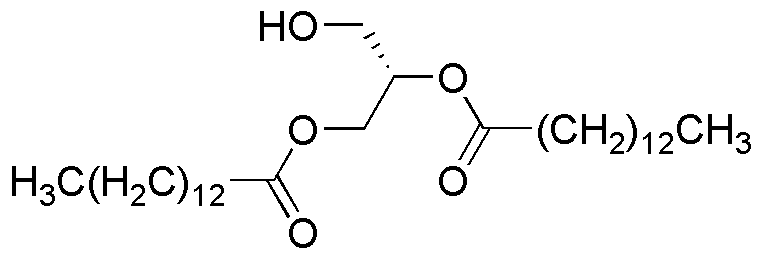1,2-Dimyristoyl-sn-glycerol is widely utilized in research focused on:
- Pharmaceutical Formulations: This compound serves as an emulsifier and stabilizer in drug formulations, enhancing the solubility and bioavailability of poorly soluble drugs.
- Cosmetic Products: It is commonly used in skincare formulations due to its moisturizing properties, helping to improve skin texture and hydration.
- Food Industry: As a food additive, it acts as an emulsifier, improving the texture and shelf-life of various food products.
- Biotechnology: In cell culture applications, it is used to enhance membrane permeability, facilitating the delivery of genetic material into cells.
- Research Applications: It is utilized in the study of lipid bilayers and membrane dynamics, providing insights into cellular processes and drug delivery systems.
General Information
Properties
Safety and Regulations
Applications
1,2-Dimyristoyl-sn-glycerol is widely utilized in research focused on:
- Pharmaceutical Formulations: This compound serves as an emulsifier and stabilizer in drug formulations, enhancing the solubility and bioavailability of poorly soluble drugs.
- Cosmetic Products: It is commonly used in skincare formulations due to its moisturizing properties, helping to improve skin texture and hydration.
- Food Industry: As a food additive, it acts as an emulsifier, improving the texture and shelf-life of various food products.
- Biotechnology: In cell culture applications, it is used to enhance membrane permeability, facilitating the delivery of genetic material into cells.
- Research Applications: It is utilized in the study of lipid bilayers and membrane dynamics, providing insights into cellular processes and drug delivery systems.
Documents
Safety Data Sheets (SDS)
The SDS provides comprehensive safety information on handling, storage, and disposal of the product.
Product Specification (PS)
The PS provides a comprehensive breakdown of the product’s properties, including chemical composition, physical state, purity, and storage requirements. It also details acceptable quality ranges and the product's intended applications.
Certificates of Analysis (COA)
Search for Certificates of Analysis (COA) by entering the products Lot Number. Lot and Batch Numbers can be found on a product’s label following the words ‘Lot’ or ‘Batch’.
*Catalog Number
*Lot Number
Certificates Of Origin (COO)
This COO confirms the country where the product was manufactured, and also details the materials and components used in it and whether it is derived from natural, synthetic, or other specific sources. This certificate may be required for customs, trade, and regulatory compliance.
*Catalog Number
*Lot Number
Safety Data Sheets (SDS)
The SDS provides comprehensive safety information on handling, storage, and disposal of the product.
DownloadProduct Specification (PS)
The PS provides a comprehensive breakdown of the product’s properties, including chemical composition, physical state, purity, and storage requirements. It also details acceptable quality ranges and the product's intended applications.
DownloadCertificates of Analysis (COA)
Search for Certificates of Analysis (COA) by entering the products Lot Number. Lot and Batch Numbers can be found on a product’s label following the words ‘Lot’ or ‘Batch’.
*Catalog Number
*Lot Number
Certificates Of Origin (COO)
This COO confirms the country where the product was manufactured, and also details the materials and components used in it and whether it is derived from natural, synthetic, or other specific sources. This certificate may be required for customs, trade, and regulatory compliance.

